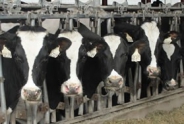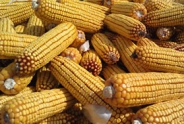Field Crop Update, August 8, 2025
Erik Smith, Area Field Crop Specialist/Team Leader
Central New York Dairy and Field Crops
1. Field Observations
Some of you may have seen this phenomenon, but almost undoubtedly, you've heard/read of it by now: "tassel wrap". Corn tassels/crowns are the male flowers of the corn plant that shed pollen, and the silks are the elongated stigmas of the female flowers on the ears that receive the pollen. Normally, silk and tassels emerge in synchrony so adjacent plants can successfully pollinate each other. But this year, in corn fields across the country - including NY - we're seeing the situation illustrated in the photo below. Emerged silk, waiting for pollen that is bound up in tightly-wrapped flag leaves. The leaves eventually release the crowns, but this delay could lead to pollination issues as seen in the second image below. Experts from across the country are trying to come up with an explanation, but so far we don't have any concrete leads. Both environmental stress (of which we've had no shortage this year!) and genetics have been suggested, and it may be a combination of the two. What is certain is that it seems to be somewhat rare, and is occurring in a variety of situations, so it's difficult to point to any one cause. We do not have a remedy at this point, and the best thing you can do is to go out and visit your fields and take note which acres have experienced this issue so that you might have an explanation for any observed pollination-related kernel problems as ears develop, or yield loss at harvest.
- Potential effects on grain: The midwest is giving us a great preview of what we can expect from this phenomenon, and that is, the most extreme cases tend to lead to ~30% grain loss in the worst ears. This is certainly significant, but this level of grain loss has not been observed throughout entire fields, and the kernels themselves are somewhat capable of "filling in" the empty spaces. Not great by any stretch, but certainly not a total loss. Most cases have shown to be less severe. So, extreme cases may lead to some grain yield losses, but so far we don't have much evidence to suggest that significant levels of yield loss will be the norm in affected fields.
- Potential effects on silage: Due to the reduction in kernels, starch levels may take a marginal hit. And there is a very speculative theory out there that this may lead to an increase in sugar levels (like we observe in male-sterile sorghum that produces no grain whatsoever). But Cornell PRO-DAIRY forage specialist Joe Lawrence tells me that because tassel-wrapped corn plants are still producing a cob with, at worst, 70% of its kernels intact, an increase in sugar - like the decrease in starch - may be very modest. So in summary, these effects may be noticeable in the hardest-hit parts of affected fields, but may in fact be diluted by the rest of your crop.
No matter what, this is a good reminder to keep an eye on your crop throughout the season, as best you can, so you might account for any potential surprises at harvest.
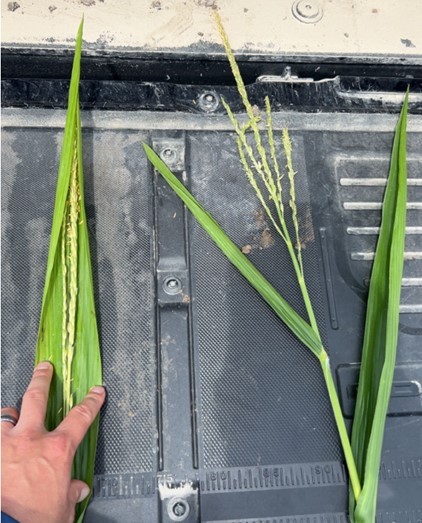
Photo: Bayer Crop Science
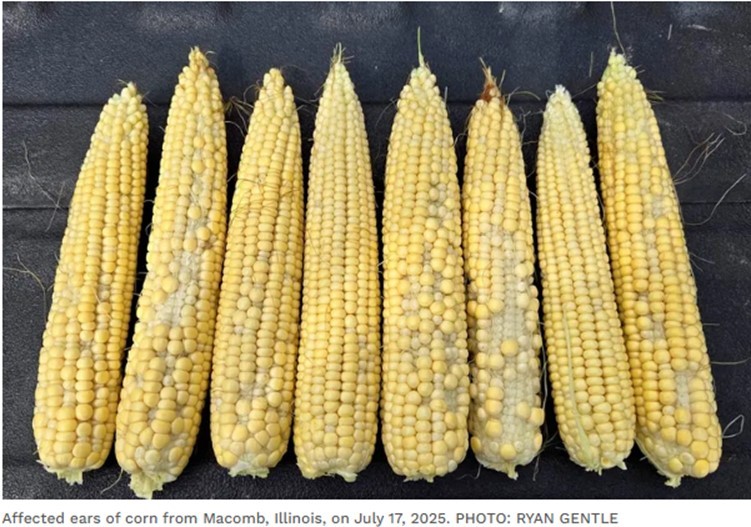
And here's our weather outlook:


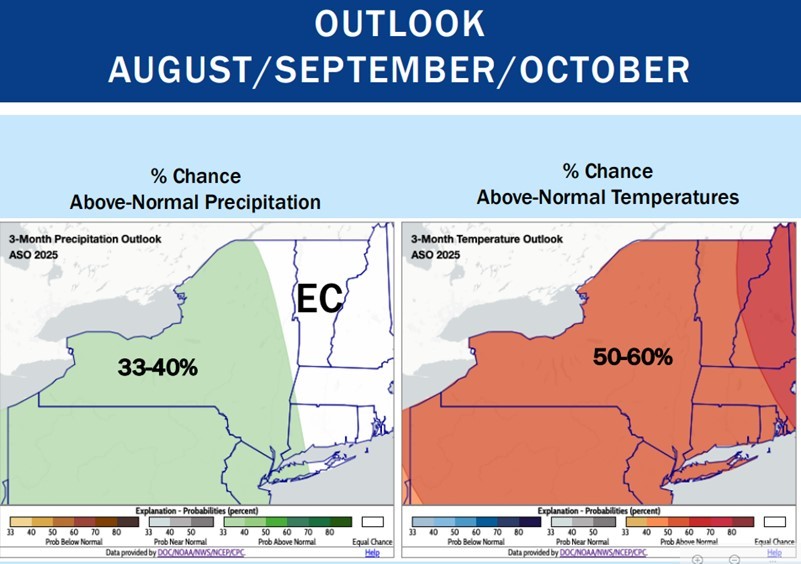
2. Pests and Disease
We're mercifully entering the last few weeks of potato leafhopper relevance (many fields are still in early regrowth and our swept fields were all at or below threshold… for now), and our corn moth (western bean cutworm and fall armyworm) trap numbers remain low. Keep an eye out for tar spot and let me know if you suspect any!
3. Growing Degree Days (GDD) (See: Climate Smart Farming Growing Degree Day Calculator)
Growing degree days (GDD) are calculated by taking the average daily temperature and subtracting the base temperature for development of a given organism ((High + Low)/2 - base temp = GDD). For corn silage, we are using base 50/86, as corn development starts at 50 degrees F and ceases above 86. Check your location and planting date.
The silking dates in section 2 begin July 17th, when I first saw tasseling in the region - so this does not mean that every crop in your particular area tasseled on that earliest date. Your crop may have tasseled on or more closely to one of the later dates. So While our GDD tables in section 2 can get you in the ballpark, check your own whole-plant DM to make sure you're ready, and not ahead/behind schedule!
Remember: Silage corn needs 750-800 GDD (depending on hybrid maturity) after silking to reach a whole plant DM of 32%. Under typical late season dry down conditions we can expect the crop to reach 35% DM four to seven days later. We can expect to accumulate 15-25 GDD per day, or even up to 30, so peak maturity can creep up on us quickly. But no matter what the numbers say, always check your crop to see how close you may be to harvest. For more details, see this article.

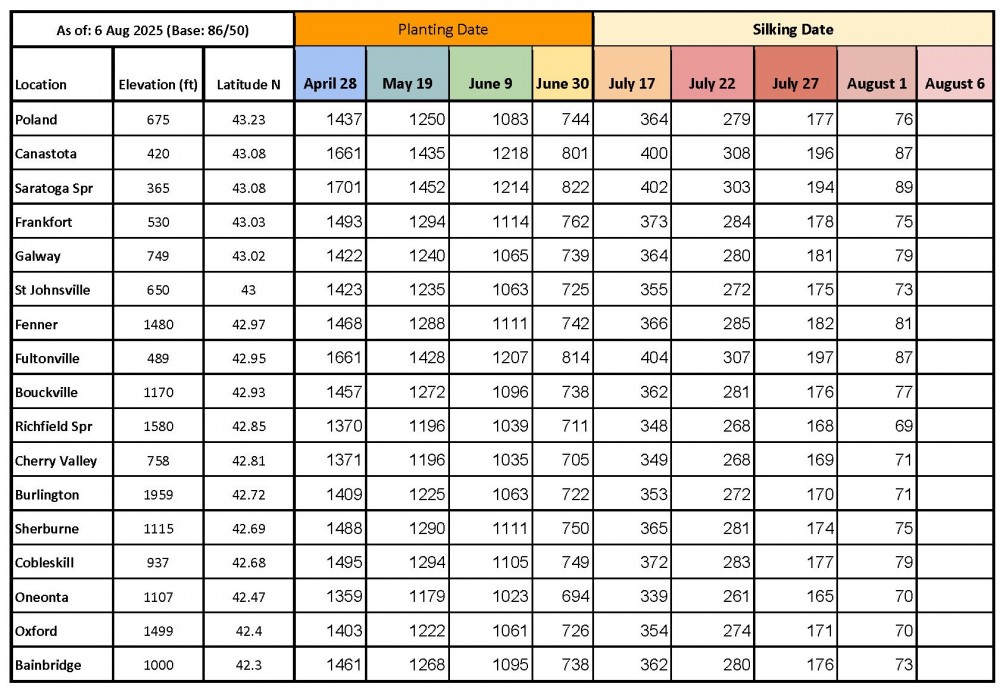
Upcoming Events
Labor Roadshow IX
December 1, 2025
December 9 - December 10, 2025December 17 - December 18, 2025December 22, 2025
In-person and online events to keep NY's agricultural employers informed and prepared for today's labor challenges.
Inspired by Annie's: How to Be a Strong Woman Farm Manager
January 10, 2026
January 17, 2026
Free webinars geared towards women who own or operate a farm in NYS.
2026 Dairy Day
January 13, 2026 : Dairy Day - Hamilton
Hamilton, NY
Lunch included
January 14, 2026 : Dairy Day - Ballston Spa
Ballston Spa, NY
Lunch included
Announcements
Statewide Field Crop Pathology Needs Assessment Survey
Your input is wanted for identifying priorities!Sign Up for Our Weekly E-Newsletter
We send out a bi-weekly e-newsletter that has announcements, upcoming programs, and opportunities for you! Registration is quick, easy, and free. Click here to sign up today!Farmers Can Join MeatSuite For Free!
MeatSuite.com is a free resource provided by Cornell University where NY meat farmers can create a farm profile and list their bulk (wholes, halves, quarters) and bundled (i.e. Grilling Bundle) meat products.Why should farmers join?
1. It's free and easy!
2. Connect with more local customers. In the past year the MeatSuite.com farm directory had 8,300 visits from New York consumers. Farm profiles get as many as 25 views per month from potential local customers. We also spotlight MeatSuite farms on social media and bring attention and purchases to farms through highlights and giveaways.
How do I join?
Farmers can visit https://www.meatsuite.com/farmers/ to create a free farm profile. You must list at least one product for your farm's profile to go live. You'll also have access to Cornell's free Meat Price Calculator, a helpful tool for pricing your meat to make a profit.
While you're on MeatSuite, check out the "Creating Consumer-Friendly Bulk Meats" publication on the log-in page. It has tips on how to create bulk meat products that are easier for first-time buyers to say "yes" to.
If you have any questions as you create your farm profile or products, we're here to help! Please email Matt LeRoux at mnl28@cornell.edu.

